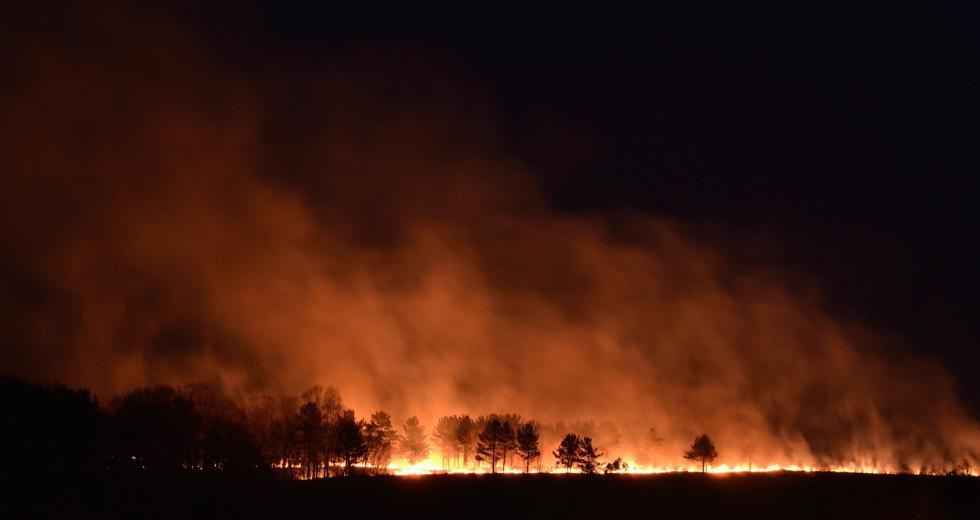Forest fires are picking up once again in California. The cause this time: rain and snow.
Yes, as counterintuitive as it would seem, the weeks of precipitation that ended the state’s drought in the spring also laid the groundwork for a surge in fires.
What happened is the deluge sparked a greening of bushes, grasses and shrubs like no one has seen in California in years; when the storms then ended and the temperatures started to soar — to around 100 degree Fahrenheit for days at a time — all of that newly sprouted foliage quickly dried out. And that provided the perfect fuel source to turn a stray spark into a raging fire.
“We have this abundant grass crop now, and we have not had this type of fuel in many years,” says Amy Head, spokeswoman for CalFire in Sacramento. “It is dry everywhere, it is thick, it is abundant and there is a lot of it.”
Some 2,905 fires started between Jan. 1 and July 9, burning more than 68,129 acres on state and local lands, more than double the five-year average of 27,390 acres and the 30,574 that burned by the same date last year. When you throw in areas maintained by the U.S. Forest Service, the total acreage aflame or scorched across the state rises to 92,439 acres. Gov. Jerry Brown declared an emergency in Santa Barbara County where two fires forced people from their homes, threatened agriculture and could even have severed major power lines and driven up electricity prices.
Power Prices
Transmission lines are ubiquitous in California, seemingly rising and falling over almost every hill. When one of those lines is cut, the supply is separated from its demand — like July 13, when 1,000 megawatts of electricity coming in from Oregon were cut off from customers in California by a fire burning near the state line, says David Quinn, a power-market analyst specializing in California at Genscape Inc. in Boston. Or sometimes, Quinn says, power will be traveling from the southern part of the state to customers in the north when a fire interrupts the line. That’ll cause electricity prices at the destination to surge while the south finds itself awash in excess electricity.
Summer fires in California aren’t anything new, of course. Around this time of year the West in general tends to start burning, says Robyn Heffernan, a National Weather Service fire weather science meteorologist in Boise, Idaho.
What is new is that the numbers and intensity of fires seem to be rising, a consequence of climate change, Head says.
Longer Burning
“They are much longer-burning, much hotter and much faster-spreading,” Head says. “There are parts of California that don’t go out of fire season.”
In 2008, when lightning touched off more than 1,400 fires across the state in a single night, then-Gov. Arnold Schwarzenegger said repeatedly that the state went from seeing many of its fires in the late summer and fall to a year-round fire season.
This year, the wet weather has played a big role: California pulled out of a six-year drought when rain and snow fell across the state, setting records in some areas. Snow acts like water in the bank, melting in the spring to help fill reservoirs and help plants grow. Across the West, residents remarked about how green the hillsides were.
Now the heat is coming back. Since June 1, the temperature has hit 100 or more at least 11 times in Sacramento, 19 times in Fresno and 14 times in Modesto, National Weather Service records show.
“A lot of grass and brush has cured out and is available to burn,” Heffernan says.
Vulnerable Trees
These type of plants grow at lower elevations, making the valleys ripe for fire outbreaks. While trees up in the higher altitudes tend to loose moisture slower than grasses, helping defend them from fire, they, too, are vulnerable now because tree-killing bark beetles ran wild during the state’s drought.
“There’s 100 million dead trees at last count,” Head says. “It is dead, standing, dry timber that isn’t coming back.”
Temperatures are rising, the air is drying out and on Monday red-flag warnings — the weather service’s alert for fire danger — covered much of Northern California into Nevada.
“It’s only July and we have the potential for a very, very busy fire season,” Head says.



